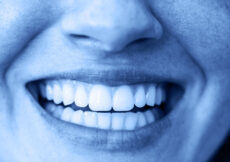
“Huh. That’s interesting. I’ll be right back.” The last words from my ob-gyn before everything changed.
“You have an enlarged placenta. We’re not sure what it means. Maybe nothing, but we need to keep an eye on it.”
Oh.
Although I didn’t know it at the time, that decision to “keep an eye on it” probably saved my son’s life. And my own.
Because from the very beginning of my pregnancy, we had the medical and financial support to not just stay healthy, but to survive. For too many women around the world, that’s far from a given.
It was my first pregnancy. I was a healthy 30-year-old—not young, but not quite geriatric. Every expectant parent worries until they hear the heartbeat, until they reach the 12-week marker. Until the baby is born, and well, forever after that, I guess. And sure, I was nervous, but optimistic—even though “keeping an eye on it” meant that when I reached the 32-week marker of my pregnancy, I’d need fetal non-stress tests three times a week, in addition to my regular prenatal appointments, to check the baby’s heart rate. Still, despite my giant placenta, this monitoring seemed like a formality.
After all, I was young…ish and healthy. I ate the right things, exercised, took care of myself, did everything by the book. And by the time I hit 32 weeks, my pregnancy had gone pretty smoothly. I never once threw up. I’d had headaches, but nothing like the migraines that had plagued me most of my life. My feet were a little swollen, but didn’t that happen to every pregnant woman?
So, on that warm, September afternoon, as I relaxed into a giant easy chair at the maternal-fetal medicine clinic, book in hand, car full of groceries destined for a weekend of grilling, I felt good. The nurse positioned electrodes on my belly and a blood pressure cuff on my arm. My blood pressure had always been unusually low—this would be a breeze.

There was zero indication that within 48 hours, I’d be having an emergency c-section to save both of our lives. Or that my son would be born so premature, so tiny, that he’d spend the first five weeks of his life in intensive care.
My blood pressure started high, though, and rose quickly. The nurse started to look concerned, checking my charts and closely monitoring my readings. By the time my blood pressure hit 160/90, I started to panic.
Googling told me that those seemingly harmless headaches and swollen limbs were probably red flags for preeclampsia—a fancy word for high blood pressure that occurs after the 20th week of pregnancy or soon after delivery. It’s rare, but serious, affecting 2-8% of pregnancies around the world. It can cause damage to other organ systems—the kidneys, liver, blood or brain. Untreated, preeclampsia can cause serious, even fatal complications such as seizures for both the mother and baby.
While preeclampsia can be managed, the only treatment is delivery.
“We’re going to need to admit you and if it keeps going up, we’re going to have to deliver the baby.”
Oh.
In my hospital room, things started going very badly, very quickly. My blood pressure kept climbing. My liver enzymes started to rise, and my blood platelets started to drop—signs of a dangerous variant of preeclampsia. My baby could die. I could die.
They prepared me for delivery.
My husband, ever calm, cool and collected, called my in-laws: “Do you guys want to be grandparents?” Well, yes, obviously. “No. Now.” They raced up from Virginia. My dad drove in from New Jersey.
A few hours later, our son was born. He weighed just 2 pounds, 14 ounces.
But he was okay.
My husband told me years later, that when our son was born, he was silent. Gray. They rushed him over to a table and started trying to get him to breathe. I don’t remember any of it. He says I asked, “Is he okay? What are they doing?” “He’s fine!” he said, but he was secretly terrified.
And then our son started screaming. Relief.
He shared the NICU space with a rotation of newborn babies—most born even earlier. Some much sicker. Some were so small, they barely looked human. Some didn’t make it. It was almost always dim and preternaturally quiet, save the constant beeping of machines and monitors, punctuated by an occasional breathing alarm or a baby screaming—or parents quietly sobbing.
I couldn’t help but think about what might have happened—if I hadn’t gone to my prenatal appointments because I couldn’t afford it or couldn’t leave work.
I know now that my prenatal care saved our lives. We survived because at that first ultrasound, my doctor noticed something was off and decided to keep an eye on it. Because I went to get the fetal non-stress test, despite feeling just fine. Because we had some of the best care in the country at the Hospital of the University of Pennsylvania. Because my doctors knew what was wrong and when to act. Because they knew what he needed not only to live, but to keep breathing, growing and thriving.
Two weeks before what would have been his due date, he finally came home.
We were met with a bill from the hospital—it was for just $1,000. Health insurance covered the rest. Three nights in the hospital, five weeks in the NICU, major surgery. One-thousand dollars—not nothing, but an amount we could afford.
Across the country, though, many parents can’t afford the prenatal and postnatal care that saved our lives. They can’t just leave work and go to the doctor or easily find child care for their older kids.
Women in the United States are more likely to die from complications related to pregnancy and childbirth than in any other industrialized nation. For Black women, the risk of pregnancy-related deaths is 3-4 times higher. And babies of mothers who don’t get prenatal care are three times more likely to have a low birth weight and five times more likely to die than those born to mothers who do get care.
In fact, 15% of American women don’t receive adequate prenatal care. Women with Medicaid are more likely than those with private insurance to report not having a postpartum visit, having less postpartum emotional and practical support at home, and returning to work within two months of birth. And nearly one in four mothers returns to work within two weeks of delivery.
Two weeks after my delivery, our son was still in the NICU. Fortunately, I received 12 weeks of paid leave, with plenty of flexibility for follow-up appointments, as well as occupational therapy—in our own home—to support our son’s physical and emotional development. We paid nothing.
The U.S. is one of the only countries in the world that doesn’t guarantee paid family leave—rather, just 12 weeks of unpaid leave, if you qualify. In fact, 95% of the lowest-wage workers have no access to paid family leave.
But if everyone in the U.S. had access, paid family leave would lead to 600 fewer infant deaths per year, in part because it increases healthy child development, improves maternal health, supports paternal involvement and enhances financial security.
President Biden’s American Families Plan would allow parents to receive partial wage replacement after delivery—up to $4,000 per month—and guarantee 12 weeks of paid family leave. Passing the plan would be an excellent start to improving the state of maternal care in this country.
Today, our son is a healthy, happy, hilarious eight-year-old who is obsessed with Roblox, gaga ball and ‘Diary of a Wimpy Kid’ books. That he was born so early barely registers with him.
I’m still somewhat at risk—particularly if we decided to have another baby. Fortunately, if we did, my prenatal care would be supported. By our family, doctors, jobs, and health care plan. We were the lucky ones, but many aren’t, and I will never take that for granted.


































